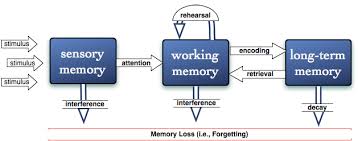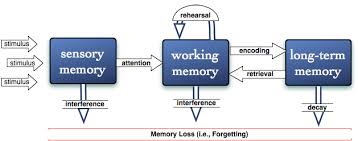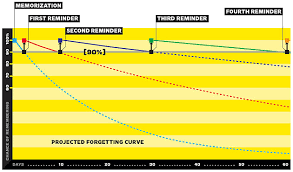Thấu hiểu được điều gì tham gia vào quá trình học
A. Đây chính là kẻ thù của bạn và nó được gọi là Đường Cong Lãng Quên( the Forgetting Curve) và nó chính là một trong những nhân tố ra đổ lỗi cho những gì chúng ta quên hay những gì chúng ta không thể nhắc lại sau đó
Bạn cần chiến đấu với nó một cách chủ động.

Như bạn có thể quan sát trên thấy, trên 60% lượng thông tin ta học được, chúng ta sẽ quên nó trong 9hs sau khi ta học nó
Nghiên cứu khoa học của hiện tượng này:
B, Còn đây là người bạn của chúng ta- Quá trình học ( Informed Learning Process)

Bất kỳ điều gì chúng ta nghe/ nhìn/ đọc được bộ não chúng ta tiếp nhân thông qua các giác quan và được lưu trữ trong bộ nhớ giác quan
Vấn đề tập trung sẽ ảnh hưởng đến giai đoạn này. If một nhân tố xúc tác không được ghi nhận bởi sự tập trung, chúng ta khó có thể recall lại sau đó
Bước tiếp theo để chuyển tác nhân kích thích từ Sensory Memory sang Working Memory và có thể lưu trữ được một lượng hữu hạn thời gian
Bước cuối cùng đó là tranfer từ Working Memory sang Long-term Memory, nơi bạn lưu trữ thông tin vô hạn và thời gian rất dài.
Những phương pháp chuyển những gì bạn học sáng Long-term Memory
1# To improve transfer from Sensory to Working memory – improve your attention/focus by
Đảm bảo chắc chắn những tác nhân gây nhiễu từ môi trường( sự mất tập trung, distractions, )
Đảm bảo cơ thể ở trạng thái thoải mái( ngủ đủ giấc, ăn uống hợp lý với những thức ăn tốt cho não bộ)
Kiểm soát mọi thứ diễn ra trong đầu: cảm xúc những suy nghĩ bất chợt
2# To Improve transfer from working memory-> long term memory
1. Understand what’s involved:
The Forgetting Curve

Over 60% of stuff we learn is forgotten within 9hrs from learning it.
Informed Learning Process
Fight the Forgetting Curve by actively transferring what you’ve read/heard/seen from your sensory-> working-> long-term memory

To improve transfer from sensory to Working memory – improve your attention/focus by
## Making sure your environment does not get in the way (interruptions, distractions, un-ergonomic workspace; manage technology
## Making sure your body is comfortable (enough sleep, eating right (‘brain foods’) foods and in the right way (sustained release of energy); schedule in breaks;managing stuff going on in your head (emotions, random thoughts, etc
To Improve transfer from working memory-> long term memory
To get what you’ve read from your short-term (working) memory that lasts about 10-15s to your long-term storage (this is the actual learning process) you go through a 3-stage process:
Xem thêm: Memory Processes
Introduction To Pyscho: Memory
– encoding
– storage
– retrieval.

To improve your ability to remember material you’ve read
Improve your encoding process:
### read for understanding;
### make notes that reflect your understanding of read passages, chapters
###write a short summary of what you have just read; you may make some other comment
Taking notes from books to boost the learning process,
I use pen and paper, because handwriting your notes enhances learning (here is the research paper:
I have a stock of small, cheap notebooks
b) Improve your storage
###By creating multiple connections with your prior knowledge.
multiple connections with prior knowledge= multiple tags=better encoding = easier to find
### creating connections’/chunking is about creating pieces of information/knowledge that makes sense to you and that you can relate to something you already know, e.g. ‘Process X is like preparing a three-layered cake, because..’ or ‘Y reminds of of Z… but with W in the middle
Fast and forever – how to learn faster and remember longer (an unauthorised guide)
Practice retrieval – using spaced repetition principles and in a variety of ways, so not just simply recall, but also being able to apply the theory to practice, e.g.
## if it’s about study material/textbook knowledge: solving problems, doing old exam questions, explaining material to others
## if it’s a non-fiction or fiction book and you’ve learnt a great tip-> put it into practice, ideally within 1-2 days; then refresh your memory at 2-week and 2-month interval (the notes you’ve made will be enough to go through
## if it’s a kind of a system you want to put into practice (e.i. GTD – Getting things done), do it immediately and keep running (regular refreshers apply)
## if it a phrase, a piece of poem etc.-> learn it by heart and use it within 24-48 hrs (e.g. in a conversation), then again and again, closely enough to not forget (1-2 weeks’ time, and then again)more here:
## The best way to remember what you are reading (about) is to take notes and then revise them or , if it’s skill-learning – put it into practice asap

Space repetition is what helps us fight that forgetting curve, this is how it works:
As you can see below, the repetitions of the material learnt are scheduled at the points where the forgetting curve drops.
Leave a comment